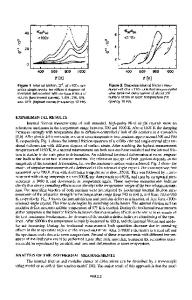Thermal Fatigue of NiAl Single Crystals
- PDF / 983,998 Bytes
- 6 Pages / 412.74 x 641.7 pts Page_size
- 24 Downloads / 499 Views
tance. NiAl exhibits two of these material properties that would make it a good choice for a high temperature structural application such as a turbine vane or blade. The first is its low density. The density of NiAl is approximately 2/3 that of the nickel-based superalloys. The decreased density results in lower self-induced stresses in the rotating turbine airfoils, allowing a reduction in turbine disk size from the resulting lower mass of the blades. Secondly, the thermal conductivity of NiA1 which is 3-8 times that of nickel-based superalloys gives a NiAl blade or vane a much more uniform temperature distribution leading to lower thermal stresses and a much improved cooling efficiency as compared to conventional superalloys. However, NiAI exhibits low yield strengths at the desired operating temperatures and low ductility at room temperature. Thermal cycling/fatigue will be an issue for this material since it is being targeted as a replacement for nickel-base superalloys in the high-pressure turbine (HPT) vane airfoil. Advanced airfoil cooling makes rapid heating and cooling more intense along the airfoil edges than in the bulk of the blade, generating cyclic mechanical strain gradients. The objective of this work was to examine the thermal fatigue behavior of single crystal NiAl. EXPERIMENTAL PROCEDURE Stepped-disk specimens of 16.6 mm diameter (Figure 1) were machined from a single crystal rod of NiAl with their faces normal to the crystal growth direction and with external radii typ-
ical of those of blade trailing edges. Note that the stepped-disk geometry was developed to induce more severe heating and cooling gradients for testing of protective coatings not present in this experiment. The change in sample geometry is not expected to have any affect on the thermal fatigue behavior. Because the anisotropic elastic material properties interact with the radially inhomogeneous temKK8.4.1 Mat. Res. Soc. Symp. Proc. Vol. 552 © 1999 Materials Research Society
peratures of the induction heating based thermal fatigue test [1], the strain range along the specimen periphery is a function of its local crystallographic orientation, changing from a maximum along the four orientations to a minimum at the four periphery orientations. To determine the effect of the various segments of the thermal cycle on the resultant plastic deformation, the disks were subjected to two different strain histories established by two different thermal profiles. The first was cycle A: a 5 s ramp from 700 to 1200iC followed by a 15 s hold at 1200iC and finished with a 20 s cool to 7001C. The second profile, cycle B, employed was a 5 s ramp from 700 to 1200iC followed by a 20 s cool to 700iC. Note that this is the same as cycle A except the hold time at 1200iC is absent. This allows determination of the effect of hold time at peak temperature on deformation of the disks. The stress and strain histories that correspond to the temperature profiles are shown in Figures 2a and 2b. These were determined by finite element analysis using ABAQUS [3]
Data Loading...











